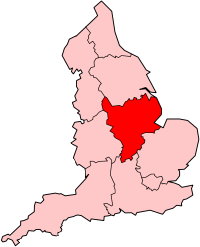Erewash Valley line
The Erewash Valley line is a railway line in Britain running from south of Chesterfield along the Erewash Valley to Trent Junction at Long Eaton, joining the Midland Main Line at each end.
Erewash Valley Line | ||||||||||||||||||||||||||||||||||||||||||||||||||||||||||||||||||||||||||||||||||||||||||||||||||||||||||||||||||||||||||||||||||||||||||||||||||||||||||||||||||||||||||||||||||||||||||||||||||||||||||||||||||||||||||||||||||||||||||||||||||||||||||||||||||||||||||||||||
|---|---|---|---|---|---|---|---|---|---|---|---|---|---|---|---|---|---|---|---|---|---|---|---|---|---|---|---|---|---|---|---|---|---|---|---|---|---|---|---|---|---|---|---|---|---|---|---|---|---|---|---|---|---|---|---|---|---|---|---|---|---|---|---|---|---|---|---|---|---|---|---|---|---|---|---|---|---|---|---|---|---|---|---|---|---|---|---|---|---|---|---|---|---|---|---|---|---|---|---|---|---|---|---|---|---|---|---|---|---|---|---|---|---|---|---|---|---|---|---|---|---|---|---|---|---|---|---|---|---|---|---|---|---|---|---|---|---|---|---|---|---|---|---|---|---|---|---|---|---|---|---|---|---|---|---|---|---|---|---|---|---|---|---|---|---|---|---|---|---|---|---|---|---|---|---|---|---|---|---|---|---|---|---|---|---|---|---|---|---|---|---|---|---|---|---|---|---|---|---|---|---|---|---|---|---|---|---|---|---|---|---|---|---|---|---|---|---|---|---|---|---|---|---|---|---|---|---|---|---|---|---|---|---|---|---|---|---|---|---|---|---|---|---|---|---|---|---|---|---|---|---|---|---|---|---|---|---|---|---|---|---|---|---|---|---|---|---|---|---|---|---|---|
| ||||||||||||||||||||||||||||||||||||||||||||||||||||||||||||||||||||||||||||||||||||||||||||||||||||||||||||||||||||||||||||||||||||||||||||||||||||||||||||||||||||||||||||||||||||||||||||||||||||||||||||||||||||||||||||||||||||||||||||||||||||||||||||||||||||||||||||||||
History


The Erewash Valley line has historic, but troubled, origins. At the beginning of the nineteenth century the Nottinghamshire coalminers had a lucrative trade with Leicester using the Erewash Canal, the River Trent and the Leicester Navigation. The Leicester miners had attempted to compete by building the Charnwood Forest Canal but this was unsuccessful. However, in 1832, they opened the Leicester and Swannington Railway.

The Nottinghamshire miners already had a tramway, the Mansfield and Pinxton Railway. They attempted to raise the funds for a railway to Leicester but found it difficult to attract investors. Their ideas developed into a line linking Nottingham to Derby and Leicester which would carry their coal from the Erewash Valley. This was the beginning of the Midland Counties Railway, and they attracted the attention of Lancashire and Yorkshire financiers. The idea developed further into a connection to the London and Birmingham Railway at Rugby. However, a proposed connection from the north of the Erewash to Chesterfield was its undoing, since it would compete with the North Midland Railway.
The building of the Midland Counties Railway went ahead without the Erewash Valley line. However, in 1844, the Midland Railway was formed through the amalgamation of the North Midland, the Midland Counties and the Birmingham and Derby Junction Railway. The Midland almost immediately acquired the "Leicester and Swannington" and the "Mansfield and Pinxton".
Finally in 1844 it built the Erewash Valley line as far as Pinxton in 1847, with a link to the Butterley Company's own railway at Codnor Park in 1849. The line was finally completed to Chesterfield in 1862.
It was immediately successful, not only serving the collieries but also the ironworks and brickworks around Ripley, particularly the Butterley Company. By the end of the century, it was also carrying main-line expresses from London to Leeds and Settle–Carlisle line services to Scotland, while the main line to Derby served the expresses to Manchester, and the main line to Nottingham used the Corby line from Kettering and ran through the now closed Old Dalby line diverting near Melton Mowbray.
The Grade II* listed disused wrought iron Bennerley Viaduct once carried the GNR Derbyshire and Staffordshire Extension over the line.[1]
Present day

With the loss of heavy industry in the area, local traffic contracted massively, yet it continues to be the second-busiest freight line in the East Midlands.
- East Midlands Railway uses this route for several of its key business morning and late afternoon services from Sheffield and Leeds to London.
- An EMR inter-urban working also uses part of the line hourly between Nottingham and Chesterfield on the Norwich to Liverpool service.
- Northern Rail from December 2008 has operated an hourly Nottingham-Leeds service on the route.
Future
Network Rail as part of a £250 million investment in the region's railways has proposed improvements to the junctions at each end, resignalling throughout, and a new East Midlands Control Centre.[2]
As well as renewing the signalling, three junctions at Trowell, Ironville and Codnor Park will be redesigned and rebuilt. Since the existing Midland Main Line from Derby through the Derwent Valley has a number of tunnels and cuttings which are listed buildings and it is a World Heritage Area, it seems that the Erewash line is ripe for expansion. As the new signalling is rolled out, train detection is moving away from the traditional Track circuit detection of trains to Axle counting.
- Part 1a – North Erewash (Trowell to Coney Green)
- Part 1b – Tapton (Coney Green to Tapton)
- Part 2a – South Erewash (Toton)
- Part 2b – South Erewash (remainder)
Summer 2007 engineering work
Signalling was renewed at a cost of £56 million over a 19-mile stretch between Trowell and Coney Green Junction via Langley Mill and Alfreton. The line was closed from 10 June 2007 until 6 August 2007 while the project was completed. Services using this route were diverted via Derby while the work was carried out. Westinghouse Rail Systems engineers installed and tested new signalling equipment along the line, GrantRail Ltd remodelled Trowell Junction, installed the new Ironville Junction and renewed three miles of track in the Stanton Gate to Trowell area and at Ironville. The closure was also used to rebuild three bridges at Langley Mill, Eastwood and Ilkeston.[3]
References
- Taylor, Alun (21 March 2018). "Fancy a viaduct? We have a wrought Victorian iron marvel to sell you". The Register. Retrieved 23 March 2018.
- "Secretary of State opens Network Rail Control Centre". Network Rail. Archived from the original on 26 September 2008. Retrieved 29 August 2008.
- "Passenger Reminder – Renewing the Railway in the East Midlands this Summer". Network Rail. Retrieved 29 August 2008.
